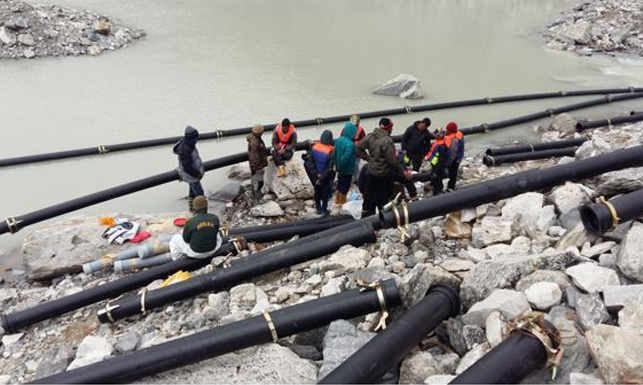

The Divecha Centre for Climate Change was established at Indian Institute of Science in January 2009 with a generous financial contribution from Arjun and Diana Divecha and the Grantham Foundation for the Protection of the Environment.
The primary goal of this centre is to understand climate variability and climate change and its impact on the environment. The Centre has undertaken outreach activities to create awareness among people and policy makers about climate change and its consequences.This has been done through workshops, lectures and quiz contests. An annual invited public lecture called the 'Jeremy Grantham Lecture on Climate Change' has been organized.

Welcome to Divecha Centre for climate Change. There are several exciting developments in research, outreach and mitigation going on at present.
I hope you find it interesting. If you have any suggestions please contact me.

Worldwide renewable installations are growing exponentially in the electricity mix. In a renewable-rich electricity grid, meeting continuously changing demand with weather-dependent intermittent renewable generation is highly complicated.

The exchange of heat, moisture, and
momentum between the Earth’s surface
and the atmosphere is commonly
discussed under the climate jargon “land atmosphere interactions”.

Despite its importance in accurately estimating atmospheric radiative forcing due to aerosols (tiny suspended particles in the atmosphere), the vertical structure and its spatial variation of aerosols remains mostly at large over the south Asian region.

Grazing ecosystems make up about
40% of the Earth’s land surface (nearly
50 million km2), storing vast amounts of
carbon (about 500 Pg) in the soil.

Renewable (wind and solar) capacity is increasing rapidly worldwide as it is essential to decarbonise the electricity grid. When there is no renewable generation, balancing the electricity demand with the available generation in a renewable-rich grid can be challenging.

In a recent study, we analyzed long-term
satellite-based lightning observations
over various parts of the Indian
subcontinent.Lightning occurrences
are most frequent along the Himalayan
foothills and the Indo-Gangetic plains.

The concentration of carbon dioxide
(CO2) is increasing on account of
anthropogenic activities. Since climate change affects both temperature
and precipitation across the world, it
also influences how vegetation can
capture carbon.

In order to transform agroecosystems
to become resilient to climate change
there is an urgent need to undertake the study of microbial interactions with
plants in the rhizosphere, a region of soil
characterized by its close proximity to
the plant roots.

A combination of low rainfall and high
temperature has a more serious impact on
society than when these occur separately.The yield of wheat crops decreases substantially when high temperature and low rainfall occur together. In a recent paper published in the journal Scienti¿c Reports..

During the past 50 years, the retreat
of many Himalayan glaciers has been
documented but these do not give us an idea about the volume of water that has been lost on account of the retreat. This knowledge is important to evaluate the impactoftheretreatonavailabilityofwater to people living near the glaciers in the Himalayas.

India has embarked on an ambitious program to expand solar power plants to a total installed capacity of 100 GW by 2022. Most people assume that electrical energy from a coal power plant is less expensive. In this study, Mitavachan and Srinivasan compare coal and solar power generation with respect to a set of seven sustainability criteria.
Read More
Isotopes are elements with the same atomic numbers but different masses.
Water is composed of one oxygen atom and two hydrogen atoms.
The oxygen atom has two major stable isotopes in nature. They are 16O (abundance 99.75%), and the heavier 18O
(abundance 0.20%) .

Soot is one of the primary air pollutants which absorbs the sunlight and consequently
warms the atmosphere.In most parts of india we find a high concentration of
soot near the ground on account firewood used for cooking
and emissions from vehicles and coal powe plants.

Most of the glaciers in the Himalayas have been receding during the past 50 years.This has led to the creation of many glacial lakes in the Himalayas. The moraine dammed glacier lakes can lead to sudden glacial lake outburst floods,the south lhonak glacier in sikkim had a lake with large volume and hence posted a serious threat to the villagers....
Read More
About 80% of the geographic area of Meghalaya is covered by forests and
tree cover. Meghalaya is a part of the Indo- Myanmar
global biodiversity hotspot and home to diverse plant a
nd animal groups.A study was carried out at the request of the state government to assess the current state....

A 20 kiloWatt (peak) solar photovoltaic system was established at Indian Institute of Science in April 2013. The system has produced around 80 kWh/ day for the past four years. The annual energy generated was around 29 MWh (MegaWatt hours). The monthly energy generated was above 3 MWh...
Read More
India has embarked on an ambitious program to expand solar power plants to a total installed capacity of 100 GW by 2022.Most people assume that electrical energy from a coal power plant is less expensive. In this study, Mitavachan and Srinivasan compare coal and solar power generation with respect to a set of seven sustainability criteria.
Read More




